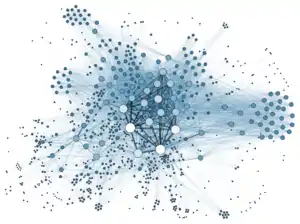 | |
 | |
| Developer(s) | Mathieu Bastian, Eduardo Ramos Ibañez, Mathieu Jacomy, Cezary Bartosiak, Sébastien Heymann, Julian Bilcke, Patrick McSweeney, André Panisson, Jérémy Subtil, Helder Suzuki, Martin Skurla, Antonio Patriarca |
|---|---|
| Initial release | 31 July 2008[1] |
| Stable release | 0.10.1[2]
/ 17 January 2023 |
| Repository | |
| Written in | Java, OpenGL |
| Operating system | Linux, Windows, macOS |
| Platform | NetBeans |
| Size | 121.1 MB |
| Available in | English, Chinese, Czech, French, German, Japanese, Portuguese (Brazil), Russian, Spanish, |
| Type | Visualization |
| License | GNU General Public License, Common Development and Distribution License |
| Website | gephi |

Gephi (/ˈɡɛfi/ GE-fee[4][5]) is an open-source network analysis and visualization software package written in Java on the NetBeans platform.[6]
History
Initially developed by students of the University of Technology of Compiègne (UTC)[7] in France, Gephi has been selected for the Google Summer of Code in 2009, 2010, 2011, 2012, and 2013.
Its last version, 0.10.1 has been launched in 2023. Previous versions are 0.6.0 (2008), 0.7.0 (2010), 0.8.0 (2011), 0.8.1 (2012), 0.8.2 (2013),[8] 0.9.0 (2015),[9] 0.9.1 (2016)[10] and 0.9.2 (2017).[11]
The Gephi Consortium, created in 2010, is a French non-profit corporation which supports development of future releases of Gephi. Members include SciencesPo, Linkfluence, WebAtlas, and Quid.[12] Gephi is also supported by a large community of users, structured on a discussion group[13] and a forum[14] and producing numerous blogposts, papers and tutorials.[15]
In November 2022, a lightweight web version of Gephi, Gephi lite, was announced.[16]
Applications
Gephi has been used in a number of research projects in academia, journalism and elsewhere, for instance in visualizing the global connectivity of New York Times content[17] and examining Twitter network traffic during social unrest[18][19] along with more traditional network analysis topics.[20] Gephi is widely used within the digital humanities (in history,[21] literature, political sciences, etc.), a community where many of its developers are involved.
Gephi inspired the LinkedIn InMaps[22] and was used for the network visualizations for Truthy.[23]
See also
- Graph (discrete mathematics)
- Graph drawing
- Graph theory
- Graph (data structure)
- Social network analysis software
- File formats
- Related software
References
- ↑ https://launchpad.net/gephi/0.6/0.6alpha1 Gephi version 0.6a1 release date
- ↑ "Release 0.10.1". 17 January 2023. Retrieved 11 February 2023.
- ↑ Grandjean, Martin (2014). "La connaissance est un réseau". Les Cahiers du Numérique. 10 (3): 37–54. doi:10.3166/lcn.10.3.37-54. Retrieved 2014-10-15.
- ↑ Gephi [@Gephi] (April 4, 2013). "@jeanburgess @timhighfield @snurb_dot_info #Gephi should be pronounced /ɡɛfi/ (how to read this: http://ow.ly/jKfqz ) #TipOfTheDay" (Tweet). Retrieved 2022-11-06 – via Twitter.
- ↑ Gephi (2022-10-08). Intro to the Gephi Week 2022 in Paris - 1/19. YouTube.
- ↑ Bastian, Mathieu; Heymann, Sebastien; Jacomy, Mathieu (2009), "Gephi : An Open Source Software for Exploring and Manipulating Networks", AAAI Publications, Third International AAAI Conference on Weblogs and Social Media, archived from the original on 2013-07-28, retrieved 2011-11-22
- ↑ Desmedt, Patrice (2011), "Sébastien Heymann - Le cartographe des données", L'Usine Nouvelle, retrieved 2011-12-14
- ↑ Liste des versions, sur GitHub
- ↑ Gephi 0.9 released
- ↑ Gephi updates with 0.9.1 version
- ↑ Gephi 0.9.2 : a new CSV importer
- ↑ "The Gephi Consortium - Members". The Gephi Consortium. Archived from the original on 2011-11-07. Retrieved 2011-11-23.
- ↑ Gephi Facebook group
- ↑ "Gephi forums". Archived from the original on 2019-11-25. Retrieved 2016-08-15.
- ↑ Grandjean, Martin (2015), GEPHI - Introduction to Network Analysis and Visualisation, retrieved 2016-08-15
- ↑ Jacomy, Mathieu (2022-11-15). "Gephi Lite". Gephi blog. Retrieved 2023-07-17.
- ↑ Leetaru, Kalev H. (2011), "Culturomics 2.0:Forecasting Large-scale human behavior using global news media tone in time and space", First Monday, doi:10.5210/fm.v16i9.3663, retrieved 2011-11-22
- ↑ Aouragh, Miriyam (2011), "Collateral Damage: #Oslo Attacks and Proliferating Islamophobia", Jadaliyya, retrieved 2011-11-22
- ↑ Panisson (2011), "The Egyptian Revolution on Twitter - Featured on the PBS NewsHour", YouTube, retrieved 2011-11-22
- ↑ Correa, Debora C. (2011), "Using Digraphs and a Second-Order Markovian Model for Rhythm Classification", Complex Networks, Communications in Computer and Information Science, vol. 116, pp. 85–95, doi:10.1007/978-3-642-25501-4_9, ISBN 978-3-642-25500-7
- ↑ Grandjean, Martin (2017). "Analisi e visualizzazioni delle reti in storia. L'esempio della cooperazione intellettuale della Società delle Nazioni". Memoria e Ricerca (2): 371–393. doi:10.14647/87204. See also: French version (PDF) and English summary.
- ↑ Launched in 2011 and stopped in 2014.
- ↑ Heymann, Sebastien (2011), 2010 Usage of Gephi, archived from the original on 2011-11-21, retrieved 2011-11-22
- ↑ "Pajek / PajekXXL / Pajek3XL". mrvar.fdv.uni-lj.si. Retrieved 2019-12-09.